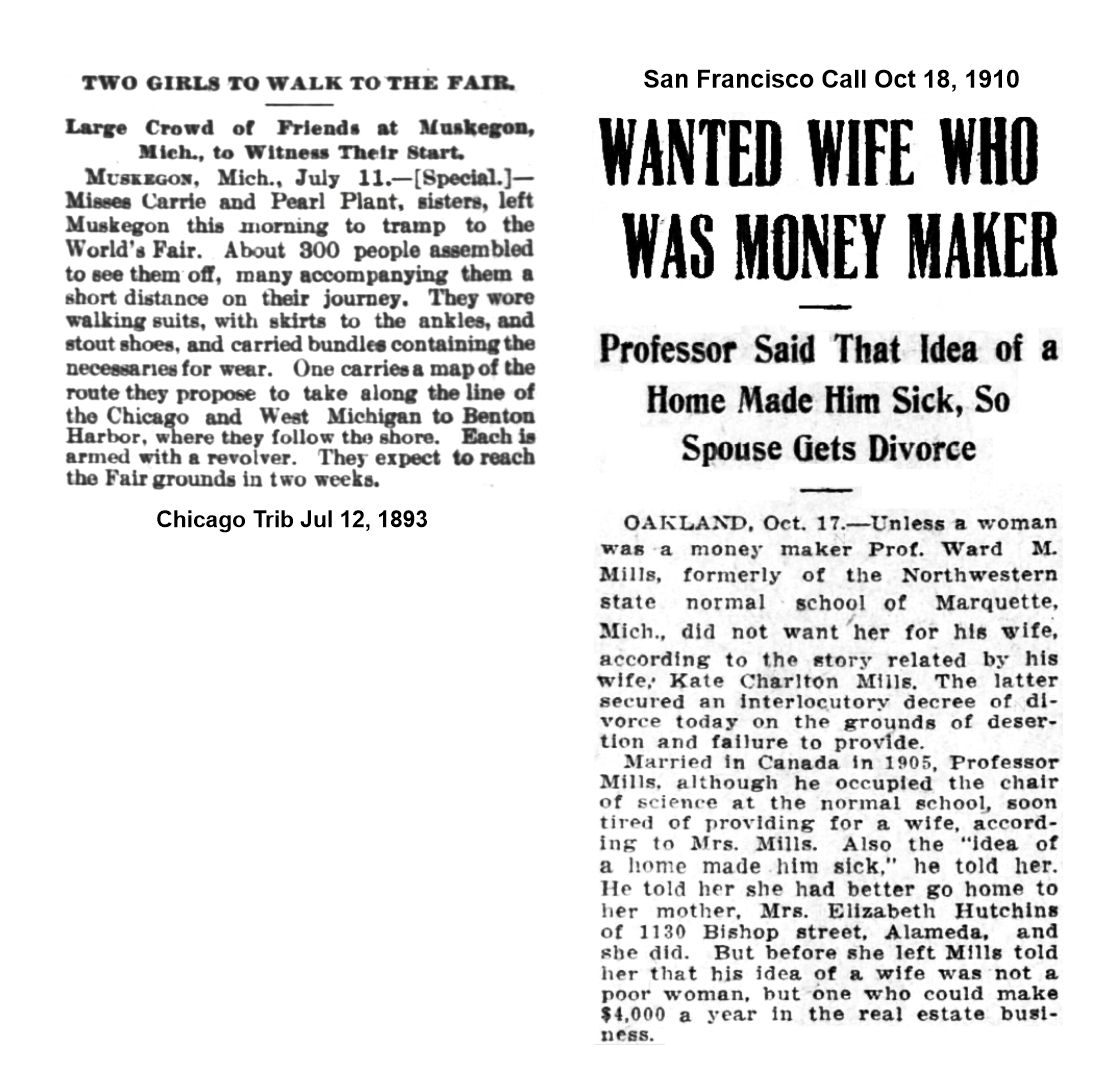|
Minnie Pearl Plant Mills b. 1872
Married in 1898, Pearl
and Ward Mills had not yet started a family when
Pearl died at the Iroquois. Both were teachers in
Chicago public schools, Pearl at the James Wadsworth
school† and Ward at the Armour Institute of
Technology and the South Division High School. Ward
taught geology and natural sciences.
Minnie was thirty-two
years old at her death. She had graduated from the
Muskegon, Michigan high school and was still taking
classes at the University of Chicago. Iowa native
Ward Magoon Mills (1865–) received his Bachelor of
Science from the University of Chicago in 1901.
Pearl was the daughter of Henry E. Plant and Jennie
Clark Plant of Crockery, Michigan. She was buried in
Nunicia, Michigan, at the Nunica cemetery. Her
closed-casket funeral was conducted by Rev.
Archibald Hadden of the first Congregational church
of Muskegon.
Agnes Isabella Mills b. 1882 or 1883
Ward Mill's twenty-year-old sister, who went by her middle
name, Isabella, also died at the Iroquois. Isabella lived
with their parents, Henry S. Mills (1837–) and Elizabeth Graham
Smith Mills (1839-), and her older sister, Dora H. Mills
(1882). Henry was a native of Ohio and Elizabeth of
Scotland. Henry was a book publisher who immigrated
to America in 1851. Elizabeth Mills had given birth to
eight children, but by 1900 only four survived,
making Isabella the fifth child she lost. Ward
identified Isabella's body at Jordan's Mortuary
after a twenty-four-hour search. She was
reportedly buried at Rosehill Cemetery in Chicago.
|

|
Julia Brewster
Also in the party, and
a fellow teacher with Pearl Mills at the Wadsworth
School, was twenty-five-year-old Mary Julia Brewster
(b. 1878), who went by her middle name. Julia lived
at 116 E. 31st street with her father and
stepmother,
Leonard Hilton Brewster (1852–1915) and Sarah
Emma Swan Brewster (1867–), and her younger sister,
Violet Garfield Brewster (1880–1967).
Julia and Violet were the daughters of Leonard and
his first wife, Mary Lavina Tapscott (1859–1883).
Mary had died when Violet and Julia were three and five
years old. Leonard remarried, but it was a
short-lived marriage, and a decade before the fire,
he married Sarah Swan. Violet Had married two months before
the Iroquois Theater fire.
Leonard identified his daughter's body.
In the years after the fire
Ward Mills married Kate Charlton in 1905 and took a teaching job in
Marquette, Michigan. By 1911 the pair had moved to
Los Angels, and his wife was granted a divorce,
citing desertion. She asserted he told her to go
home to her mother after becoming involved with
another woman, a prosperous realtor. In 1920 Ward
was still teaching school and reported his status as
married, but his wife did not live with him. I
didn't find evidence of another marriage.
Julia Brewster's father moved back to Battle Creek,
and her sister and husband (Robert T. Alexander)
moved to Nebraska.
|

|
|
Ward Magoon Mills (1872–1927)
At age twenty-one Pearl Plant had packed a
gun and set out with her sister on a two-hundred mile hiking
trek to Chicago from Muskegon, Michigan. Plucky girl. Five years
later when that same woman married Ward Mills, she signed
up for a man who might at the Iroquois might have told his
sister, wife and her friend, "See ya on the street, I'm outta here!"
Ward Mills was a case. In 1907 he was
thrown out of a teaching position in Battle Creek, Michigan for
fomenting an uprising of fraternity boys against the school
principal. He moved to California.
The clipping above from 1910 is an abbreviated version of his
divorce from the woman he married a few years after Pearl's death.
The longer story includes the
man's mother testifying against him and revelations about
multiple other women, including the one he wanted to replace his
wife. He told his wife that the idea of making a home with
her made him sick, and that his new prospect was not only
prettier but that her $4,000 annual income from her real estate
business would compliment his own business interests. Then
he sent his wife off to live with his mother in Alameda.*
When testifying in the divorce proceedings, his mother described
him as "eccentric."
In 1914 he began segueing from teaching
science to assaying for palladium and antimony.
By 1926 he and his third wife, a woman named
Daisy, engaged in questionable land sales that landed them in
court.
At Iroquois hearings some witnesses spoke of
men who clawed their way through the crowd at the Iroquois,
shoving, flinging and stomping women and children to clear their
own escape path. The perpetrators weren't identified in
newspapers, of course, but Ward Mills sounds like the sort of
fellow who didn't spend thirty seconds helping the women in his
party escape.
|
|
|
